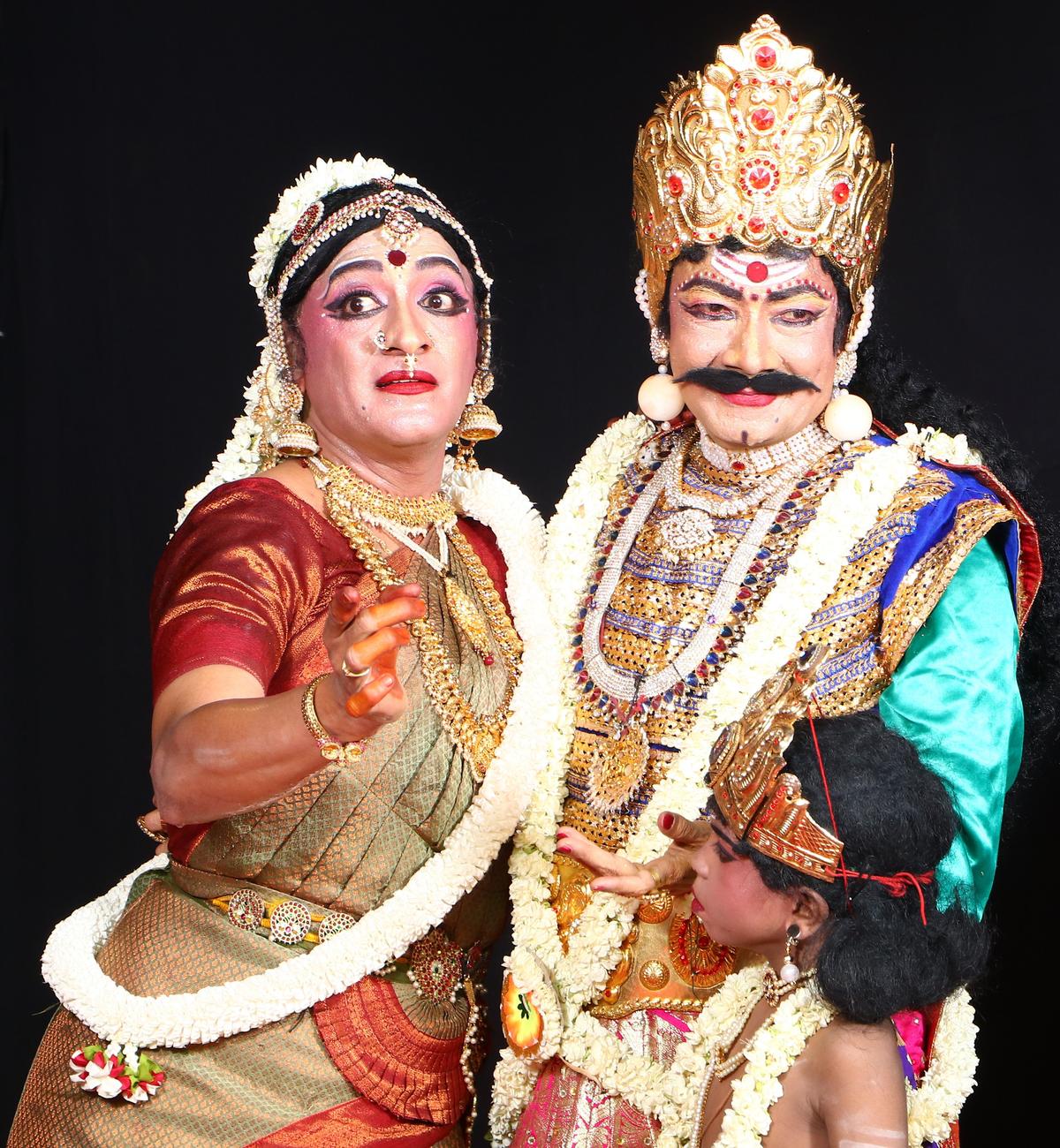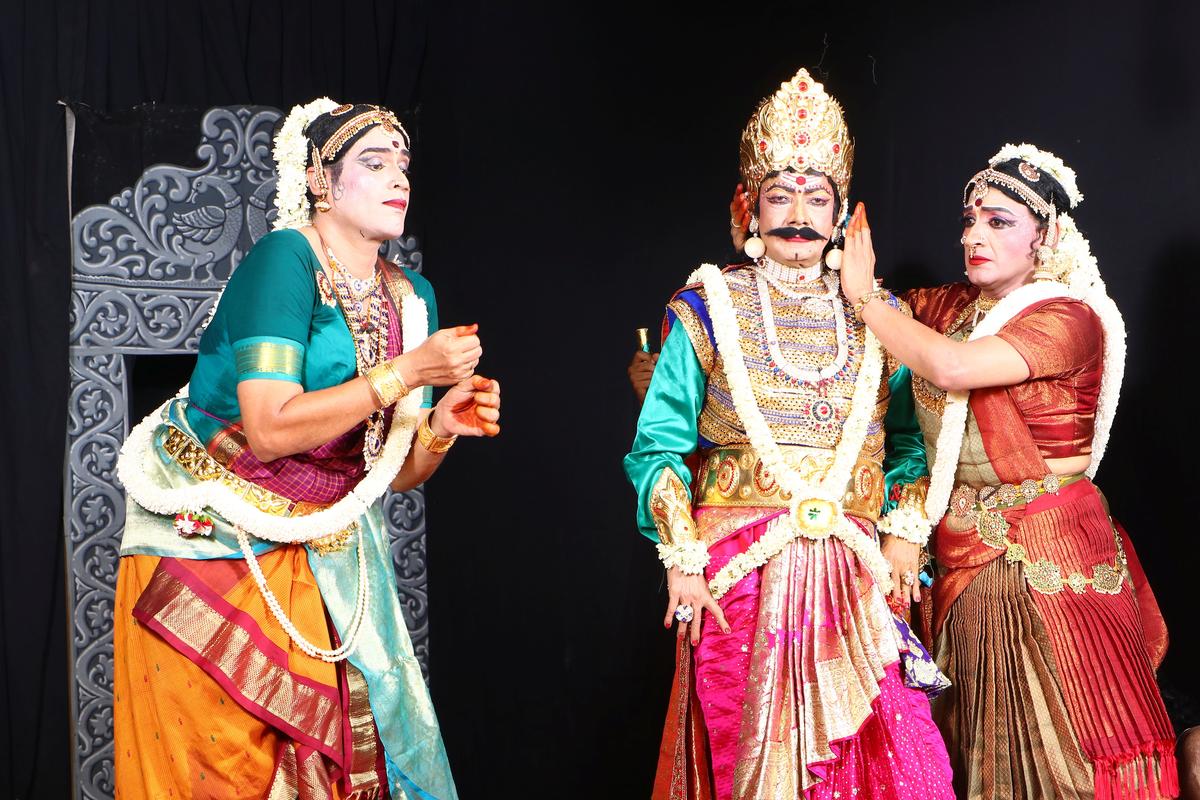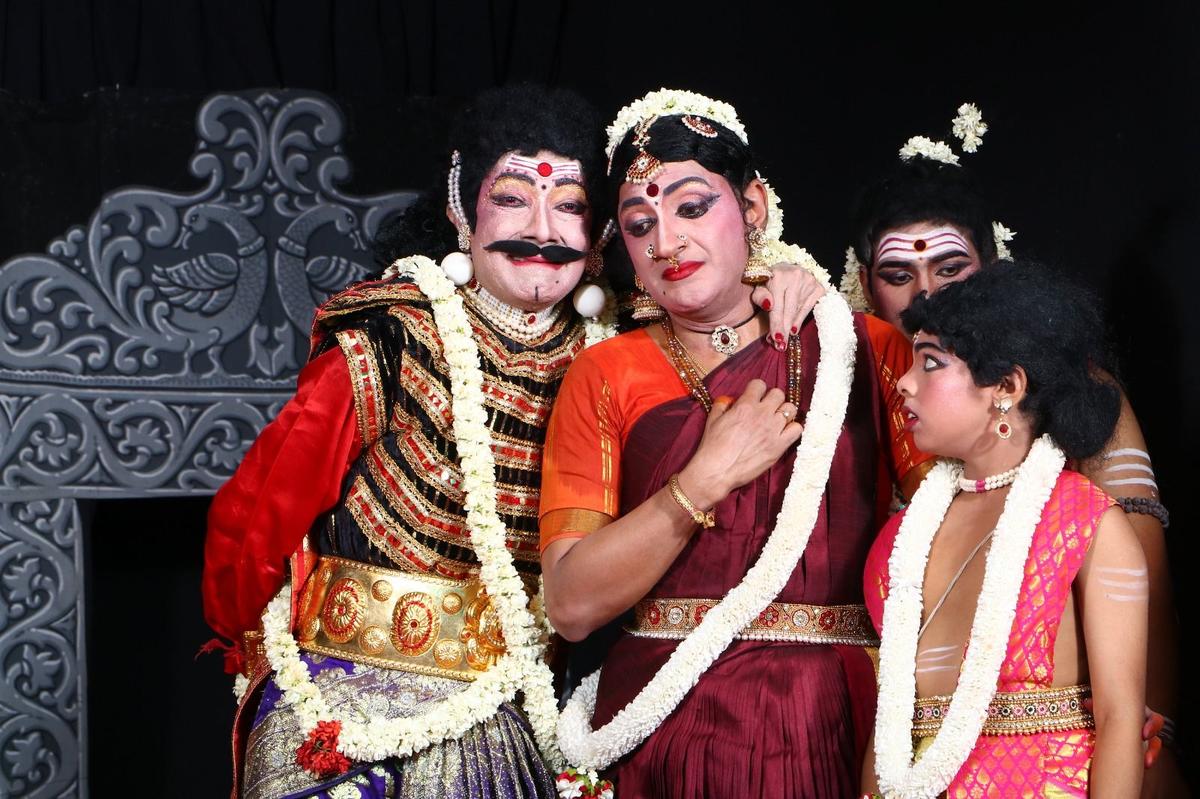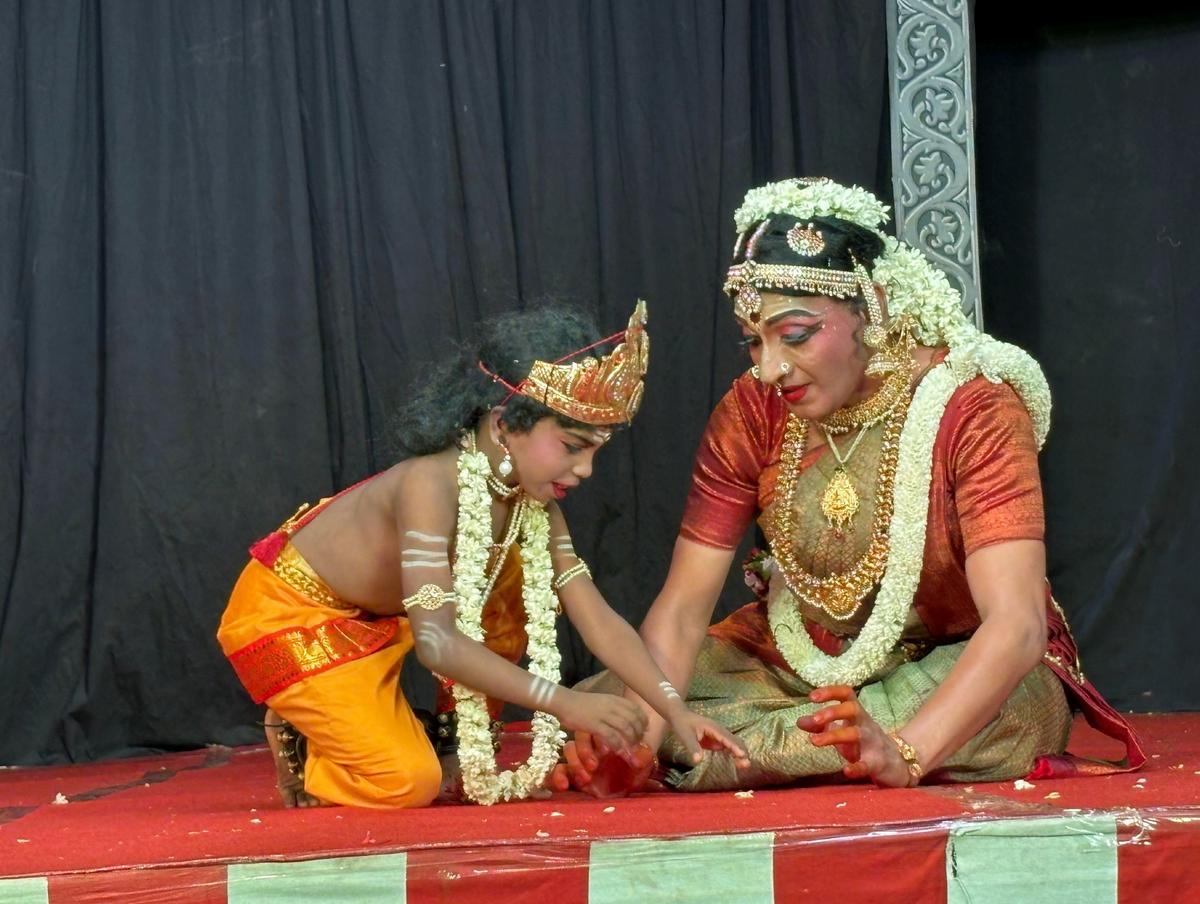Every year in the month of May, a village near the Chola kingdom of Thanjavur lights up with much pomp and splendor. The Hindu festival of Narasimha Jayanti, celebrated in the month of Vaisakha, holds great significance for this village and hence a grand dance-drama festival lasting fortnight is celebrated here.
Melattur is truly an art village as it has given birth to some of the finest artists, musicians and personalities who have made unparalleled contributions to the arts. Even today, plays composed by eminent playwright Melattur Venkatrama Sastry are staged to honour the great artistic heritage of this village. The unique and heartwarming hospitality extended by the villages to their guests needs no elaboration. Members of every household escort the visitors to the Varadaraja temple where a stage has been erected in front of the deity on the street.
Maintaining a tradition like Bhagavata Mela is a huge task and the festival continues to flourish today thanks to the efforts of many artists and art lovers. The family of renowned dance guru and Bhagavata Mela expert Melattur S. Natarajan continues to organise the festival even after his demise. Natarajan’s brother Kumar took over and took several steps to ensure that a large number of audiences attend and most importantly, they understand the importance of the tradition.
The entire celebration is broadcasted live for the benefit of the global audience. In addition, Kumar has released several videos on the group’s official YouTube channel, featuring each member, highlighting the nuances of the tradition, so as to highlight their individual contributions as well. Performance slots are also given to budding dancers and prestigious dance schools who participate with participation to be a part of this grand tradition.
Music plays a vital role in this dance-drama form. The plays require a special approach to perfect the lyrics. And Melattur S. Kumar’s portrayal of Harishchandra, which uses footwork extensively, is in sync with the music and percussion. | Photo courtesy: NC Srinivasaraghavan
Bhagavata Mela plays always prove to be a musical delight and this aspect must be examined separately to fully understand the charm of these plays. The twelve Telugu plays written by Venkatrama Shastri are full of traditional daaruvu of various contexts – Pravesh daaruvu, Uttara Pratyutara daaruvu, Samvad daaruvu, Svatata daaruvu, Pralab daaruvu, etc. Each daaruvu is a gem in terms of the literary and musical devices that Venkatrama Shastri has incorporated. Using the finest poetic expressions in the dialogues as well as in the lyrics of the songs, Shastri has ensured that lovers of the Telugu language enjoy every phrase. Each character has a unique personality and each character’s Pravesh daaruvu (self-introductory introductory) attempts to paint a picture of the character’s qualities. The daaruvu are set in difficult ragas like Ahiri, Ghantya and Manji apart from the dense ragas like Sankarabharanam and Arabi. It is worth noting that Venkatrama Shastri’s musical expertise is evident in how he completely disproved the notion of using a particular raga only for a certain rasa or personality type. For instance, a character entry can be heard in raga Atna representing Veera rasa for a beautiful female character. A strong and fearsome male character surprisingly uses Kalyani, a raga that is generally considered to represent grace and beauty.

From the play Devram Part 2. | Photo Credit: Photo Courtesy: Melattur Bhagavatha Mela Natya Nataka Sangam
Carrying forward a great guru tradition dating back to Saint Thyagaraja, the Thiruvaiyaru Brothers (S. Narasimhan and S. Venkatesan) along with L. Prabharan lead the music orchestra that is an integral part of these plays. Perfecting the songs that form part of the Nritya-Natakam requires a special approach as it requires the musicians to follow the artistic vision of the composer in terms of the ragas and the overall mood, besides working closely with the dancers on stage. It is positive to see that the children of these singers N. Venkatasubramaniam and V. Venkitakrishnan are now assisting them in preserving the family legacy. Other long-time instrumentalists who form part of the orchestra include Lalgudi K. Ramprasad on the violin and B. Gokulakrishnan on the flute, who contribute immensely to the plays through calculated musical interludes and aesthetic raga entries, besides accompanying the singers.
The mridangam is of great importance in the dramas and requires knowledge of the subject matter of the songs as well as anticipating the movements of the dancers on stage and synchronizing with their feet. Nagai P. Sriram single-handedly provides the percussion support, giving the much-needed rhythmic variety to every line that is repeated several times with different lyrics in a typical Bhagavata Mela Daruvu.

From the play Devram Part 1. | Photo Credit: Photo Courtesy: Melattur Bhagavatha Mela Natya Nataka Sangam.
Drama Devram Covering the life saga of King Harishchandra, it focuses on his sufferings while struggling to fulfill his promises made to Sage Vishwamitra, who demands his entire wealth and even his kingdom. Playing the title character, senior Bhagavata Mela artist Kumar has retained a typical style of presentation associated with the lead male characters. With extensive use of footwork associated with music and rhythm, as in the Yakshagana tradition, as well as lip-syncing to the song being sung with proper expression, Kumar’s unique portrayal of Harishchandra must be appreciated as a rare skill. Kumar learnt the basics of this style from his father, the late G. Swaminathan, and put in a lot of effort to inherit the finer aspects. Kumar’s performance skills particularly stand out when his character is forced by circumstances to work at a crematorium
Senior dancer Srikanth Natarajan, who has been part of the Bhagavata Mela for the past 45 years, plays the role of Chandramati, a role previously held by the late veteran Melattur Natarajan. Srikanth, who is known for his mature Satvikabhinaya, performed the role well. A special daaruvu reserved for Chandramati in Raga Ghanta is one of the highlights of the play. The daaruvu talks about Chandramati reminiscing the privileged life she led before she was forced to work for an elderly man. Srikanth’s Lokadharmi in which he portrayed Chandramati doing daily chores was quite believable. Nagai Sriram’s mridangam enhanced the musical quality of this daaruvu. Srikanth’s expressions on hearing the bad news of Chandramati’s son Lohitaksha’s death were poignant and soulful There is no doubt that Chandramati’s character is an integral part of the play and no one could have played it better.

From the play Harishchandra Part 2. | Photo Credit: Photo Courtesy: Melattur Bhagavatha Mela Natya Nataka Sangam
Matang Kanya is a seductress sent by Vishwamitra to seduce Harishchandra. The character is fiery, flirtatious and provocative. Senior dancer Vijay Madhavan has a distinct Rasik base for the portrayal of this character and has over the years developed and sculpted this character with a personal touch. It would not be an exaggeration to say that Vijay gradually explores the multicoloured personality traits of Matang Kanya every year. This time he chose to use a ladder to carry himself on stage while playing the veena in Nadanamkriya Daruvu. The tense situation between Matang Kanya and Chandramati, when they throw shade at each other in rivalry, is a sight to behold in itself. Vijay must be applauded for his expert handling of explicit makeup in these pieces, which suits the nature of this seductive female character.

From the play Harishchandra staged at the Melattur Bhagavata Mela Festival. | Photo Credit: Photo Courtesy: NC Srinivasaraghavan
Bhagavata Mela brings together people of different age groups and this is a positive feature of these plays. Children like Rakshith A and Sudarshan S played Lohitaksha with sincerity. Eighty-year-old R. Varadarajan amazed the audience with his authentic portrayal of the King of Kashi. Special mention must be made of Venkatasubramaniam who played the role of Nakshatriya, a comical character that made the audience laugh. Young dancer Sundaresan Pandurangan was an apt choice for the character of Madanvati. It is encouraging to see that children of present-day actors and dancers play roles in these plays. It is important to gradually pass on the art to younger dancers to ensure continuity and this is something Kumar is consciously working on.
One suggestion to make the plays more audience-friendly would be to make available copies of books containing the Telugu Daruvu and lyrics and Tamil/English translations of the dialogues, so that even those who do not know Telugu can fully understand the nuances that highlight Venkatrama Sastry’s literary brilliance.